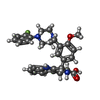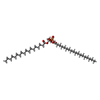+Search query
-Structure paper
| Title | Structural basis for activation of voltage sensor domains in an ion channel TPC1. |
|---|---|
| Journal, issue, pages | Proc Natl Acad Sci U S A, Vol. 115, Issue 39, Page E9095-E9104, Year 2018 |
| Publish date | Sep 25, 2018 |
 Authors Authors | Alexander F Kintzer / Evan M Green / Pawel K Dominik / Michael Bridges / Jean-Paul Armache / Dawid Deneka / Sangwoo S Kim / Wayne Hubbell / Anthony A Kossiakoff / Yifan Cheng / Robert M Stroud /  |
| PubMed Abstract | Voltage-sensing domains (VSDs) couple changes in transmembrane electrical potential to conformational changes that regulate ion conductance through a central channel. Positively charged amino acids ...Voltage-sensing domains (VSDs) couple changes in transmembrane electrical potential to conformational changes that regulate ion conductance through a central channel. Positively charged amino acids inside each sensor cooperatively respond to changes in voltage. Our previous structure of a TPC1 channel captured an example of a resting-state VSD in an intact ion channel. To generate an activated-state VSD in the same channel we removed the luminal inhibitory Ca-binding site (Ca), which shifts voltage-dependent opening to more negative voltage and activation at 0 mV. Cryo-EM reveals two coexisting structures of the VSD, an intermediate state 1 that partially closes access to the cytoplasmic side but remains occluded on the luminal side and an intermediate activated state 2 in which the cytoplasmic solvent access to the gating charges closes, while luminal access partially opens. Activation can be thought of as moving a hydrophobic insulating region of the VSD from the external side to an alternate grouping on the internal side. This effectively moves the gating charges from the inside potential to that of the outside. Activation also requires binding of Ca to a cytoplasmic site (Ca). An X-ray structure with Ca removed and a near-atomic resolution cryo-EM structure with Ca removed define how dramatic conformational changes in the cytoplasmic domains may communicate with the VSD during activation. Together four structures provide a basis for understanding the voltage-dependent transition from resting to activated state, the tuning of VSD by thermodynamic stability, and this channel's requirement of cytoplasmic Ca ions for activation. |
 External links External links |  Proc Natl Acad Sci U S A / Proc Natl Acad Sci U S A /  PubMed:30190435 / PubMed:30190435 /  PubMed Central PubMed Central |
| Methods | EM (single particle) / X-ray diffraction |
| Resolution | 3.3 - 3.7 Å |
| Structure data | EMDB-8956, PDB-6e1k: EMDB-8957, PDB-6e1m: EMDB-8958, PDB-6e1n: EMDB-8960, PDB-6e1p:  PDB-6cx0: |
| Chemicals |  ChemComp-CA:  ChemComp-FJ7:  ChemComp-PLM:  ChemComp-HOH:  ChemComp-3PH: |
| Source |
|
 Keywords Keywords | membrane protein/inhibitor / Ion channel / Two-pore channel / TPC1 / resting-state / closed / inactive / MEMBRANE PROTEIN / membrane protein-inhibitor complex |
 Movie
Movie Controller
Controller Structure viewers
Structure viewers About Yorodumi Papers
About Yorodumi Papers












 homo sapiens (human)
homo sapiens (human)